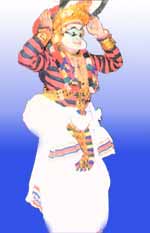|
|

|
|

|
|||
| Semi Classical Dance | ||
 For the common people, a parallel tradition of sacred
recital to Koodiyattam emerged known as Pathakam. The champus was
written in Malayalam instead of in Sanskrit by Punam in the fifteenth
century and others in every succeeding century. Similar recital emerged
as a third level known as Pana-Thottam Humour was invariably present and
dominated in all the three categories. But the other aesthetic flavours
were in no way neglected. There are passages in Punam which cannot be
read without the eyes brimming over. The recited was by one person, he
could play many dramatic roles and the form broadly corresponded to the
Sanskrit Bhana which had only a single actor. This tradition was finally
culminate in the Thullal. The Koodiyattam could not meet the heavy competition
from other more popular forms.
For the common people, a parallel tradition of sacred
recital to Koodiyattam emerged known as Pathakam. The champus was
written in Malayalam instead of in Sanskrit by Punam in the fifteenth
century and others in every succeeding century. Similar recital emerged
as a third level known as Pana-Thottam Humour was invariably present and
dominated in all the three categories. But the other aesthetic flavours
were in no way neglected. There are passages in Punam which cannot be
read without the eyes brimming over. The recited was by one person, he
could play many dramatic roles and the form broadly corresponded to the
Sanskrit Bhana which had only a single actor. This tradition was finally
culminate in the Thullal. The Koodiyattam could not meet the heavy competition
from other more popular forms.
Koodiyattom is a temple art performed traditionally by a specific community. It belongs to the genre of drama. Koodiyattom is probably the only surviving form of the traditional presentation of Sanskrit drama. Koodiyattom embraces elements of music and dance. The performance is confined to the temple theatres known as Koothambalams, the performing artists belong to specific temple dependant communities known as Chakkiars and Nambiars. The Chakkiars are the actors and the Nangiars of the Nambiar community undertake female roles to the accompaniment of the Mizhavus (pot-like drums covered with animal hide) and Edakka (a small drum played with a stick), Kurumkuzhal (a small wind instrument similar to a Shehnai) and Kuzhithalam (a small pair of cymbals).
The Koodiyattom as it is presented today was choreographed some ten centuries ago by King Kulasekhara Varman with the assistance of his friend Tholan. The form of presentation is highly stylised in Aharya Abhinaya (make-up, costume and scenic spectacle), Angika Abhinaya (gesture) and Vachika Abhinaya (oral rendering). The attempt is to present Puranic characters in a superhuman form, in an epic setting.
The performers use make-up similar to Kathakali but are permitted speech, albeit in a stylised manner. The make-up is symbolic of the nature of the character presented on the stage. At the same time, there is no typifying of characters as in Kathakali.
Koodiyattom plays are not presented in full. Presentation is so elaborate, nowadays these plays are presented only in parts - each part being known by a different name. Each performance is confined itself to one Anka (one act). Since one Anka of the drama alone is performed at one time, there is a prelude to this performance called 'Nirvahana' during which one of the characters sums up the story presented in the earlier acts of the drama and possibly the earlier stories. This 'Nirvahana' takes many days and if this 'Nirvahana' is rendered by the Vidushaka, it is an oral exposition. Other characters use hand gestures for this purpose.